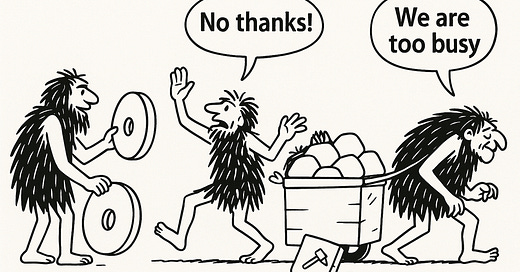Friday Forward - Idea Resistance (#487)
When leaders rush to wondering how they'll implement an idea, they may not see why it's important to do in the first place
Last week, I was meeting with a CEO I’ve been coaching to discuss an important potential change to a key process in his business. As we talked, I noticed something: even though the CEO agreed logically that the change was necessary, he was hesitant to commit to doing it.
As I delved into this CEO’s resistance, I noted he wasn’t against the idea personally, and wasn’t even concerned his team would reject it. Instead, the resistance was more subtle and almost subconscious.
Eventually, I identified the problem. This CEO was struggling to commit to the change because he assumed he would personally need to drive the initiative, and he already had too much on his plate.
This is a dynamic I’ve seen play out repeatedly over the years, particularly with leaders, high-performers, or people who naturally take on more responsibility. When they see something that needs to be done in addition to their already full plate, their first instinct is to ask: “How on earth am I going to do this?” If the answer is unclear or seems too difficult, the entire idea can quietly die right there.
But this is a trap. And it’s one that organizations need to be vigilant about avoiding.
Too often, people collapse three questions into one:
What’s the right thing to do?
How will we do it?
Who will be responsible for doing it?
Blending these questions causes teams to kill valuable ideas before they even get off the ground. When team members go straight to the how behind an idea, rather than focusing on why it’s so important, they can get too overwhelmed to examine the initiative objectively.
It’s much better to separate these questions completely. First, align on what needs to happen. Is this the right idea or change? Will doing it create better outcomes for the business, the team, or the customer? Is it aligned with our strategy and values? If the answer to all these questions is yes, it’s necessary to commit to the idea and figure out the details from there.
Once there’s clarity on what should be done, the team can tackle the how and the who. At this point the conversation broadens. Teams should ask:
Who is best equipped to lead or support this?
Do we have someone internally who has the right experience or bandwidth?
Could we bring in an outside contractor or consultant to help?
Is this something that needs to happen now, or can we schedule it for later?
If we have too much going on to do this right now, what can we deprioritize to make room?
This brings us back to the CEO I was coaching. Once I asked him directly whether he had to lead the change himself, his resistance softened. When we talked about alternative paths, such as delegating the work or tapping into other external resources, he re-engaged with the idea.
Counterintuitively, this scenario can often strike people who are high-performing and highly accountable. These top performers are natural problem-solvers, which makes them great at getting complex things done. However, the downside is highly capable people often feel obligated to do all the fixing themselves, and their desire to do everything personally becomes a bottleneck.
But this approach doesn’t scale. One person, or even a few, cannot carry the weight of an entire organization’s necessary evolution. It’s not a good idea to let them try.
A strong organization’s leadership doesn’t design strategy based solely on who’s available to execute it. Instead, a leader defines the right direction first, then aligns the people and resources to bring that strategy to life. That often means making bold decisions, then rallying the right mix of internal talent, external partners, and systems to execute.
When good ideas die too early, it’s often because someone puts the cart before the horse. As a leader, your job isn’t to do everything yourself, it’s to ensure the right thing is accomplished by the right people at the right time.
Next time you or someone on your team hesitates about an idea that clearly makes sense, pause and ask: Are we pushing back on the what…or just feeling overwhelmed by the who and how?
Quote of The Week
“Don’t let what you cannot do interfere with what you can do.” – John Wooden
Have a great weekend!
-Bob
robertglazer.com
You May Also Like:
New Article: Get On Track In 90 Days
Keynotes: Book Me To Speak
New on the Elevate Podcast: Brittany Hodak On Creating Superfans Of Your Brand And Business




This is so spot on! I have frequently been in the CEO's shoes and sometimes "one more good idea" feels like the straw that is going to break the camel's back. Even taking the time to delegate it properly (clear goal, measurable outcome, guidelines about how you want the work accomplished) seems overwhelming. On the other hand, sometimes the leader's role is to create focus and prioritize among many promising paths. It's challenging to know the difference.
Great insight. Thanks